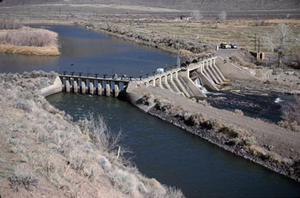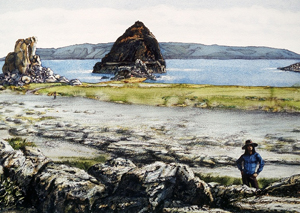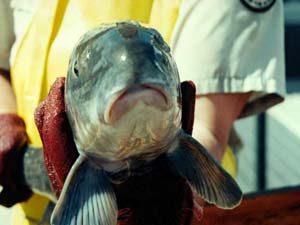
There’s nothing imposing about Derby Diversion Dam. It’s only 31 feet high, a gated, concrete structure flanked on the left by an earthen embankment. Situated on the Truckee River about 20 miles east of Reno, Nevada, the little dam makes no claims to unique design or construction. But when it comes to the history of water in the West, Derby Dam stands tall as the first project of the brand new U.S. Reclamation Service (today’s Bureau of Reclamation), organized under the Reclamation Act of 1902. The act committed the Federal Government to construct permanent works--dams, reservoirs, and canals--to irrigate arid lands in the West. The Reclamation Act was a bold Federal experiment in internal improvements that laid the foundation for a powerful government presence in water matters in the West.
On March 14, 1903, Secretary of the Interior E. A. Hitchcock authorized five Bureau projects. Among them was what became known as the Newlands Project, named after Nevada Congressman Francis Newlands, who sponsored the Reclamation Act. Not surprisingly, a dam in Newlands, Nevada launched the project. Begun on October 2, 1903, and completed in May 1905, Derby Dam diverted water from the Truckee River basin through a canal to a reservoir on the Carson River, 32 miles to the south. Today, the Newlands Project provides irrigation water for about 73,000 acres of cropland in the Lahontan Valley near Fallon, Nevada, and bench lands farther west, near Fernley.
The story has not always been a happy one. As early as 1908, just three years after completion of the dam, problems were apparent. Irrigation water from the Truckee did not always drain properly after application, and too little was available late in the season. Over time, farmers created an irrigation district and built an extensive drainage system, but many farmers were unable to meet their obligations. There would be congressional legislation and lawsuits. The dam also has been an issue for the region’s fish population and the American Indians who depend on fish for food.

The Truckee River originates in Lake Tahoe and flows east into a Nevada jewel--Pyramid Lake, a natural, desert lake of great importance to the Pyramid Lake Paiute Tribe. The members have traditionally taken their name--cui-ui eaters--from the cui-ui, (pronounced kweē-weē), a gray-brown fish weighing up to 7 pounds that occupies habitat near the lake bottom. The cui-ui (Chasmistes cujus), and equally notable Pyramid Lake Lahontan Cutthroat Trout, (Oncorhynchus clarkii henshawi) migrated from Pyramid Lake up the Truckee to spawn during high spring flows from March to June, and then returned to the lake. Prior to the 1900s, the Bureau of Reclamation’s Rick Christensen and Brent Mefford write, the cui-ui traveled as far as 25 miles upstream, and the Pyramid Lake Lahontan Cutthroat Trout as far as the Sierra Nevada Mountains.
Problems occurred as irrigation water diverted from the Truckee River lowered the level of Pyramid Lake and caused a large sandbar delta to form at the mouth of the river, blocking migrations except in high flow years. The impact of the dam on fish moving upstream to spawn was recognized early on by the Bureau of Reclamation, which built a fish ladder at Derby Dam, though how long it remained in service is not known. Despite the Bureau’s efforts to provide fish passage, Derby Diversion Dam was one of several significant factors that led, in 1940, to population extinction of the Pyramid Lake Lahontan Cutthroat Trout. At the time, Craig Springer writes, it appeared that this native strain of Pyramid Lake trout was gone forever.
Other developments on the Truckee River also impacted fish populations. In 1859 Virginia City’s Comstock Lode led to a rush of gold and silver mining activities so intense that the Truckee and other waterways became clogged with sawdust and logging debris. Among the first acts of Nevada’s new Territorial Assembly, in fact, was to demand that all dams allow for natural transit of fish, a law often ignored. More ditches and dams began to appear, diverting water from the Truckee to irrigate crops or power mills. Then Derby Dam and the Truckee Canal were constructed, diverting water south to the Carson River. In 1915, as part of the Newlands Project, the Bureau of Reclamation also built Lahontan Dam on the Carson River. Behind that dam, Lahontan Reservoir stores Carson River water, as well as water diverted from the Truckee River. By 1967, with increased diversion of Truckee River water, natural evaporation from Pyramid Lake, and severe droughts, Nevada’s “blue jewel” reached its lowest level on record – more than 87 feet lower than it was in 1906 when diversions from Derby Dam began.

Many public and private groups, as well as the Pyramid Lake Paiute Tribe, have worked to restore Pyramid Lake and recover its fish. In the 1970s, a new population of Lahontan Cutthroat Trout--which genetic studies found to be pure representatives of the original lake-dwelling trout--was introduced into the lake. The species was saved, Springer explains, when someone, at an unknown point in the past, transferred some of Pyramid Lake’s native trout into a small, fishless stream on Pilot Peak in Utah. This strain is now an active brood stock being recovered at the Lahontan National Fish Hatchery in Gardnerville, Nevada.
In 1975, the Bureau of Reclamation completed Marble Bluff Dam and the Pyramid Lake Fishway, about 3.5 miles upstream from Pyramid Lake. The dam manages the sand bar problem on the upper Truckee, while the fishway and corresponding locks provide a passageway for fish to move from the lake into the river to spawn. Known as the Marble Bluff Fish Passage Facility, this complex also includes a fish handling building, where biologists sample a small portion of cui-ui as they pass through the locks during the spawning season. They weigh, measure, determine the gender of the fish, and check for tags. This helps them understand the recovery needs of cui-ui and to assess their life history and population trends.
The Marble Bluff Fish Passage Facility recently began an incubation system for Lahontan Cutthroat Trout eggs, which allows the newly hatched trout to be raised in and imprinted with water from the Truckee River. In 2007, its first year of operation, the incubation system produced approximately 28,400 Lahontan Cutthroat Trout fry, which were stocked into upstream tributaries of the Truckee River.
The news has been positive for the cui-ui, as well, although it still is listed as endangered by the U.S. Fish & Wildlife Service. (The Lahontan Cutthroat Trout is listed as threatened.) The number of spawners increased steadily throughout the 1990s––from 66,000 in 1994 to 500,000 in 1998. In 2005, the Marble Bluff Fish Passage Facility reported that the run reached 1.2 million.
Visit the National Park Service Travel Bureau of Reclamation's Historic Water Projects to learn more about dams and powerplants.
Last updated: January 13, 2017
